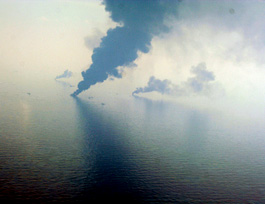home | north bay bohemian index | news | north bay | news article

Photograph by Jeffrey Warren
SMOKE ON THE WATER: Oil burns near Isle Grande Terre in this June 18 shot taken as part of the Oil Spill Crisis Map team.
Text Marks the Spot
Gulf residents help map the oiled Gulf Coast from their phones and kites
By Alex Woodward
Over the past few months, as oil from the Gulf of Mexico has poured into the coast, more than 1,300 text and Twitter messages, emails, phone calls and iPhone apps have alerted the Louisiana Bucket Brigade (LABB) to facilitate one of the largest publicly available, citizen-driven, oil-response efforts: a map.
In May, the LABB launched its Oil Spill Crisis Map project, which collects data from residents along the Gulf Coast, whether they're reporting oil on shores, suspicious odors, soiled wildlife, threatened livelihoods or health problems. The reports are added to a map, giving the LABB an idea where complaints are coming from relative to where monitors are set up by the Environmental Protection Agency.
"What we're finding is that people have health complaints and they have exposure complaints, but the EPA monitors aren't there," says LABB director Anne Rolfes. "So the map is doing exactly what it's supposed to do, which is inform response—inform the federal agencies where something more should be happening."
In a July 20 review of the EPA's air-monitoring reports from the Gulf, the LABB compares notes with EPA data collected from the beginning of the disaster to July 10. The review says the EPA isn't catching the reports that appear on the LABB map. According to the review, the EPA's monitors aren't positioned at the best spots for monitoring public health concerns such as elevated levels of the carcinogens benzene and hydrogen sulfide, which the EPA found are high throughout the region. The LABB's review recommends the EPA set up more stationary and mobile monitors and train locals, particularly out-of-work fishermen, to take samples so the EPA can get a more accurate picture of public health in more populated areas.
"The EPA is doing sampling; the citizen reports are saying, 'It's smelly here' or 'We don't feel well.' They're really different from each other, but the great thing is one can inform the other," Rolfes says. "Policymakers will look at it and say, 'We need to drive our response here.' Certainly we're hoping the EPA will use the information to refine its sampling."
Tulane University students Nancy Mock and Nathan Morrow helped develop the map, which utilizes an open-source Ushahidi platform, software first used by Kenyan bloggers to map reports of violence following that country's 2007 presidential election. The platform also has been used to aid disaster- and emergency-response efforts following the earthquake in Haiti and blizzards in Washington, D.C., and Atlanta.
Rolfes says the map will remain active, even as BP slows the gusher at the Deepwater Horizon well.
"I think there's going to be a huge temptation, now that it's controlled a little bit, to pretend like, 'Oh, it's done. The spill's over,' when of course it's just begun," she says. "I think this map will illustrate that. [It will] continue to be out in the fields, out in the communities, encouraging reporting. Documenting the problems is the only way we're going to solve the problems."
The LABB also is helping map from a different point of view—1,500 feet off the ground. Bucket Brigade volunteers are assisting Jeff Warren, whose Grassroots Mapping project sends up kites and helium-filled balloons equipped with special cameras that photograph the coast from high in the sky.
With Gulf accessibility an issue for the public and the media, Warren set out to create high-resolution images of oil impacting the coast and make them available in the public domain. Fundraising for the endeavor began through Kickstarter.com, a website that helps project coordinators gather financial backing through pledges. The campaign sought pledges to help pay for kites and cameras as well as protective gear and gas. (It met its fundraising goal on June 21.)
To develop the images, Warren partnered with Stewart Long of Gonzo Earth, a photo-mapping company, and Oliver Yeh of 1337arts, a Massachusetts Institute of Technology–based art and science project that takes photos from the sky and also sends out webcam-equipped and internet-controlled cars to collect video.
The first images were collected in May and sent to MIT, where they were stitched together, pixel by pixel.
Project organizers hope to continue mapping through January 2011 and enlist local fishing boats and crews to send out volunteers to document oil off the coast.
Images and digitally stitched maps are available for download at www.grassrootsmapping.org/gulf-oil-spill.
Send a letter to the editor about this story.
|
|
|
|
|
|